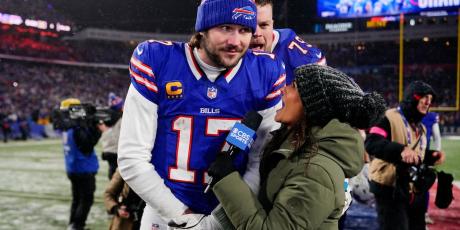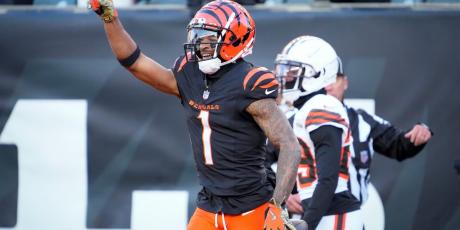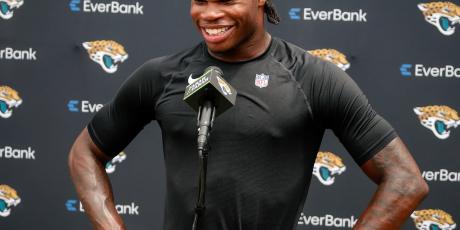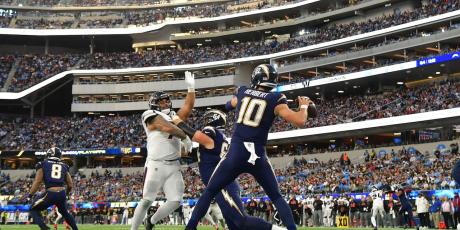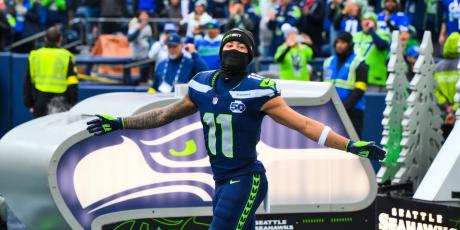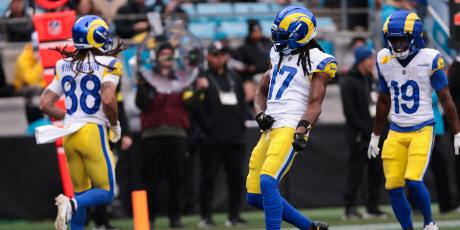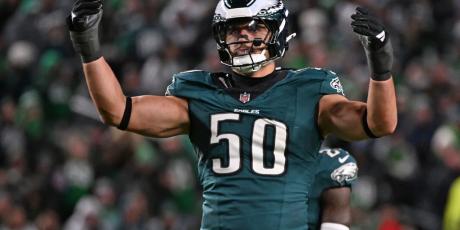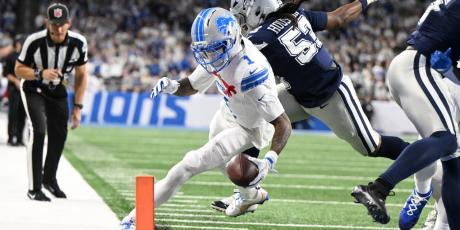Pre-Draft Rankings Versus Post-Draft Realities

This article will discuss how we think about the game of dynasty fantasy football that we play. More specifically, how we think about rookie drafts. We'll dive into the 2021 rookie draft class later on, but let's ease into this without getting bogged down in player-specific analysis. If you need a good dose of player takes, warm up with Eric Moody's sleepers. In his last piece for 4for4 (a tear), Eric, as always, does some great work.
Now, let's think about the way we think for a minute. Obviously, we are not all the same. We all have our own wiring and we all process fantasy information in our own unique way. Or do we?
More 2021 Rookie Resources: Dynasty Winners & Losers | 18 Rookies Who Can Make an Immediate Fantasy Impact
Groupthink
In the fantasy football community, as in many communities, there is an element of groupthink. If you spend a lot of time on social media or in fantasy chat rooms, you may start to view the field much the way your group does. If you spend significant time on Twitter, you will see how the fantasy community can allow its leaders to have significant sway on how the collective values individual players.
Expert X hit big on player Y and Z last draft season and now he says that Q is hip to be square this year. As winter morphs into spring, we see Mr. Q rising up pre-draft boards. As folks make their own boards, they engage in debates, adopt the takes of Expert X and his or her takes become theirs. It happens every year, and not just in fantasy football. When you boil it down to its essence, it's a form of recency bias.
The point I want to make here is that the herd will tend to move as one and when we get a sticking point like the one above, a herd will not exactly turn on a dime. Many will lag behind, stuck on old information for various reasons. As individuals, we can be light-footed as long as we avoid the herd mentality.
Our Egos and Take Lock
Most fantasy players enjoy a good player debate, and when we debate on social media or even in our smaller circles, we are aware people are listening—people whom we respect and would enjoy respect from in return. It can be a tough space when it comes to changing your mind. Nobody, myself included, wants to admit they were wrong. I get it, but if we ignore new information to protect prior stances or positions, we have entered the "Take Lock Zone" and it's a treacherous place to be.
Sometimes people get so locked in that they just can't adjust. Remember the folks who kept taking Hakeem Butler in round one after the NFL told us he was a Day Three talent?
Why did those folks get stuck on take lock? In many cases, they probably let their egos and or emotions into the process at sub-optimal levels. Fantasy footballers are a prideful bunch. We all struggle with admitting we were wrong, or even less than fully right. There's a reason they teach the sunk cost fallacy in economics, psychiatry and philosophy classes.
We all put a lot of time and effort into our processes, to hone our evaluations. We want them to matter. It's human nature, but you know what, so are vanity and overconfidence. The point is, in dynasty, the post-draft arena is a place to fight some of your natural human impulses.
"And so castles made of sand, slip into the sea, eventually." - Jimi Hendrix
Imagine being asked to map out an unexplored space, like a cavern or a maze, with roughly 50 percent of the required information. It would be a challenge, right? You'd make some educated guesses and do the best you could with it, but you know there's no way you'd get everything right.
That's a little bit like what we do before the NFL weighs in on Draft Day and plants their flags, sending a wave of havoc towards our carefully crafted sandcastles. There is no avoiding the wave, so the best thing to do is embrace it and create a plan that incorporates its arrival.
Be Flexible
So after months of working and grinding, a wave of new information just trashed your elaborately crafted sandcastle. You loved that castle, damn it. I get it. There is a natural urge to rebuild it the same exact way, but we have new information, so it's a good time for some reassessing. Perhaps that second solarium was an exercise in vanity. That moat was a tad medieval, wasn't it?
An optimized process will take the work that still holds up to scrutiny and coalesces it with the new reality the NFL just dropped on all of us.
They know what they are doing, mostly.
The dust is settling on the NFL Draft. This is the point in our timeline when we really need to let reality rule. I know there is an undercurrent amongst some hardcore NFL fans and fantasy players that the NFL is dumb. "It's an old boys club. I could run that team" or "this is the team who thought player X was good. I'm not taking any of their guys" are the kinds of things we hear all the time. In some cases, it can be true, but keep your eye on the big picture. The bulk of NFL talent evaluators earned their jobs, and the ones who didn't, do not have much sway with the ultimate decision-makers. With all due respect to the collective pain of Lions, Jets and Jaguars fans, NFL teams, in most cases, are run by qualified professionals.
Know When You're Outgunned
The NFL has all the advantages on us. Setting aside the expertise gap, they have more film than us. They have access to higher-quality film than us. They have better data than us—proprietary data. They have access to more crucial information than we do. They have budgets and staff while most of us have a laptop and a dream. This is the kind of context we should never lose sight of. Even if you dispute the notion they know more about football than you do, their logistical advantages are hard to understate.
My humble advice is to consider drafting behind the experts to some degree. The NFL is doing a lot of the work for you. Don't fight against the tide, let the current work for you.
What Matters to Us VS. What Matters to Them
While the NFL has us outgunned, it's also important to understand the NFL's priorities relative to our own. "Running backs don't matter" is a phrase we've all heard far too often. No matter where you land in that debate, it's a tired discussion. Still, the concept has merit, so let's shed the slogan and get to the actual paradigm as I see it.
Here is a quick summation. In real life, running backs are plentiful, so they command less value in the NFL marketplace. They get paid less and they cost less to acquire in most cases. Moreover, most teams have a good stable of backs and are not forced into need drafting. Hence, good running backs can slip in the NFL Draft for reasons other than how good they are or how teams have them ranked relative to their position.
Now think about fantasy football. How many of your leagues were won by teams with mediocre running backs? I'm not talking about the mode of acquisition, I'm talking about performance. You can be a ZeroRB or Robust QB drafter but you still need to find some production. In fantasy football, and especially in non-Superflex leagues, running backs are our teams' engines. We're not going far without them. They are integral.
I was fortunate enough to have the venerable Rich Hribar on my podcast last year. Rich explained that, in fantasy football, being average at running back costs you more than being average at other positions. This is due to the difference between baseline performers and the guys at the top of the position. The gap is widest for the backs, so relative to cost, you gain more by being elite at running back than you do at wide receiver.
We need to manage these two concepts simultaneously. The NFL has an oversaturated running back market while we have a finite market with scarcity. Their apples become our oranges.
The Rookie Dynamic Shift
Rookie drafts are so incredibly different from redrafts or even startup drafts. They are obviously a lot smaller with 3-6 rounds in most cases. However, in my view, the two things that make them unique are the year-to-year variability in terms of player quality and the element of pre-existing rosters.
Here is an extreme example, just to make the point clear. Imagine your rookie draft class consisted of different types and models of cars. One year, you could be looking at an assortment of Lamborghinis and Ferraris. The next year, the best player available might be a Subaru Forrester or worse. Meanwhile, the third and fourth rounds might be an assortment of late-model Chryslers. Maybe the Chryslers even encroach into the back half of round two.
Aesthetics aside, and not accounting for personal taste, there is a market for cars. There are Blue Books. We know what cars are worth. So, again, imagine that the cost for acquisition was not money, but the use of your allotted "car pick." You walk into the showroom and there are the Ferraris and Chryslers and Subarus and more—all side by side.
Now say you live on a mountain in the north and you deal with snow and loose gravel and so on going to and from your home. You clearly want the Subaru four-wheel all-terrain option. Would you actually take that option when you can take the sports car and sell it for roughly eleven Subarus, though? In that clear-cut real-life situation, 99 out of 100 people would take the Ferrari and do the leg work to gain roughly $200,000 in profit.
Why are so many dynasty GMs hesitant to employ the same concept? In most cases, it's the pre-existing roster and its relative weaknesses. They have a need to fill. Much like take lock, need drafting can get you into a lot of trouble. That being said, the threshold for what actually qualifies as need drafting is debatable. To me, if it's close, going need is not a big deal. Having tiers on your board can help a lot in this area. When the value gap is material, then you have to consider selling the pick outright or trying to trade back. If you can't make that happen, then you need to think about taking the player who has the most value. That is generally the best way to stay ahead of your opponents over the long haul.
Regarding Sleepers
Everybody loves a good sleeper, but be wary of the whole "devil you don't know" thing. There is a tendency to give up on players who have underperformed for the unknown.
The prevailing fantasy winds contain a whole lot of hot air. Players who disappointed last season sit at the loser table. Players who just got drafted have positive buzz and the fantasy wind blows at their backs. The trick for us as fantasy GMs is to judge these players who are sitting at different tables by the same measuring stick.
This brings me to how league and roster size affects the standard for adding a rookie. The more roster spots you have, the more realistic it is to have draft-and-wait talent on your team. Do your own math.
I have a league with 20 spots plus a five-man taxi squad. I have a league with 30 roster spots plus 15 taxi spots. The level of rookie talent required to be rostered in one league is not the same as the other. Hence, my rookie boards are stacked differently in those two leagues.
Sleepers are fun. We all want to hit them, but don't let it become a game within the game, because you can get your priorities mixed up. Rookie drafts are not for showing off. They are for improving your hand. Who cares who made the best fourth-round pick if none of the guys taken there ever moved the needle? I ask myself this question every time I am on the clock: Can anybody left move the needle? It's a good clarifying question.
Think About Your Draft Board Differently
As we discussed above, every year is not the same. The 1.01 selection will always be the one you want the most, but the amount you should be willing to pay is all about the player you will select, not about what the 1.01 is worth on some generic value chart. The overall strength of the class is another important factor.
You might say, "Hey, I'm no scout and I'm not an expert in analytics, how do I know whether to move up, move out or stand and select?" There's no easy answer, but there are ways to protect yourself in times of uncertainty. One is to do what you're doing right now and endeavor to incorporate different points of view. Contrast your rankings against 4for4's rankings. If you are a film-based evaluator like me, look at what the analytics say about the class. If you are a data-driven evaluator, talk to some film buffs who you respect.
Ultimately, if you do not like the depth of the class, sell your picks that fall outside of the projected window of quality. If I have done exhaustive rookie work and project there to be 17 players who merit me spending my draft capital on and committing a roster spot to. After that, I'm looking to keep all of my picks where those 17 options should be available. The rest get sold or are held back to use as sweeteners so I can move up. Maybe I sell them off for picks in future years. The one thing I do not want to do is make those picks when I have no desire for the players. I've seen teams do this just because they enjoy "the action." Find your action by maximizing your team's assets.
Be wary of the "next guy on the list" mentality. Know where your list changes from projected assets to projected waiver-wire fodder. Create a rankings list that reminds you of tier drops. Make your rankings league-specific. In general terms, look to expand your board in deeper formats or when you are rebuilding. Contact it in smaller ones or when your roster is stacked.
As alluded to earlier, craft a pre-draft process that allows for, if you will, post-draft retrofitting. This is something I have done with my board over the years—putting less emphasis on player grades and much more emphasis on skill set evaluation. The reason for this is not a lack of confidence in grading players, but there's more value in understanding their games and what specifically makes them successful.
Here's why... As mentioned earlier, the NFL has me and my laptop outgunned. They are going to invest millions upon millions of dollars in player evaluations, and in the end, it's a grade represented by the player's draft capital, which is largely quantifiable. Player X has an overall grade and a grade relative to those at his position. For example, player X was the 100th overall selection and the RB5.
We have a grade. We also have a destination or landing spot. Here's where things become less quantifiable for me. Here's where my film work on players' skill sets become married with the new NFL reality. This is an area where my process likes to get its hands dirty. I'll put my qualitative thumb right onto the quantitative scale. I will apply what I know about a player's skill set and whether I detect synergy with his new surroundings. I may see some, none, or perhaps, even the opposite. My draft board is adjusted accordingly.
In addition to scheme and or team fit, I look at the destination depth chart. Regardless of how much we like a prospect, we have to be cognizant of what type of competition he is walking into. For example, Aaron Rodgers was drafted by a team that had Brett Favre. Patrick Mahomes was taken by a team that had Alex Smith. Any reasonable assessment would conclude Mahomes was in a better position to overtake his competition. Thusly, we should see some payout sooner.
That's a quick summation of how I do it. Your process may be exclusively data-driven, and that is fine. My advice on methodology is pretty simple. Know your strengths and understand your passions. If you can find a process that keeps you motivated while also falling into your area of expertise, you are on the right track.
A Look at the 2021 Draft Class
Here are a few 2021 examples of how I make post-draft alterations to my pre-draft evaluations. Four players gained value and four lost some.
Post-Draft Risers
Trey Lance, QB, 49ers
Trey Lance was my QB4 going into the draft. He was the third quarterback drafted. What moved him on my board was his landing spot and the 49ers' cost of acquisition. They went all in and that generally leads to a strong long-term commitment. Lance's running potential already had him high on my board, but going to a team as well coached as the 49ers makes me even more comfortable about him succeeding. He now resides in Tier One and can reasonably be taken anywhere from QB1 to QB3.
Travis Etienne, RB, Jaguars
Travis Etienne was an established target going into the draft but he's even more appealing now. I love that he is being paired with his college quarterback in a scheme where their familiarity at the mesh point could lead to rookie production. Look for a fair amount of RPO action with new head coach Urban Meyer running the show and Trevor Lawrence under center.
Kadarius Toney, WR, Giants
Kadarius Toney was a riser in my pre-draft work. His lack of experience at receiver opened my mind regarding his relatively underdeveloped route tree. I raised his grade up from a late-third to a mid-second pick. The Giants then selected him with their first-round pick (20 overall), making him the draft's fourth receiver selection. This solidified Toney as a target. That other teams were looking at him is good to hear. Toney still drops to the WR6-WR8 area in a lot of drafts due to a poor pre-draft reputation. Thusly, I am trying to let him fall to me rather than jumping up or using a first-rounder on him.
Rondale Moore, WR, Cardinals
I'm excited about Rondale Moore's skill set, like most folks are, but I wanted a landing spot that worked with his skill set as I saw it. Arizona fits that bill. Moore should have an opportunity to contribute significantly as a rookie. While being a short receiver paired with a short quarterback is a concern, Kyler Murray's mobility is a big plus on the other side of the scale. I'm a buyer in the right situation.
Post-Draft Fallers
Rashod Bateman, WR, Ravens
This one hurt a bit as Rashod Bateman was a receiver I liked a ton in my pre-draft work. In my view, this is a sub-optimal landing spot, and it did cause a slight downgrade for Bateman. That being said, he is still the same talent and he did go in round one. I am willing to buy in depending on the price. The obvious concerns are how to project Lamar Jackson's development as it relates to timing and accuracy and how we project pass volume in Baltimore going forward. In my view, we'll see incremental upticks each year.
Tutu Atwell, WR, Rams
I like watching Tutu Atwell play, and he could stick in the league for a while, but at his size, I have no faith in his durability or ability to play major snaps. He's also got a tough depth chart to climb up in the near term. For these reasons, I am not following the NFL's path and am valuing him significantly lower than his draft capital suggests we should.
D'Wayne Eskridge, WR, Seahawks
D'Wayne Eskridge gets a slight bump up my rankings because I had him very low going in. Still, despite his second-round draft capital, his rookie age and landing spot are potential issues. Seattle has pass volume concerns and multiple established target hogs.
Mac Jones, QB, Patriots
I like Mac Jones and if he had landed in say, Atlanta, he would have received a bump in my rankings. New England is a different story. Bill Belichick could care less about offensive stats. In fact, Belichick finds fantasy stats offensive. Jones's fantasy outlook is now tethered to how Belichick wants to play and the current Patriots look more early-career Tom Brady than the Randy Moss and Wes Welker years.
Bottom Line
You just got a dose of how I like to prepare my rookie board. I hope it gave you an idea or two on how you can look at things differently. To sum up, be wary of groupthink and endeavor to take advantage of it. Be mindful of need drafting without being militant about it. Keep your emotions and ego in check. Respect the NFL's expertise as best you can. Be open-minded if not enthusiastic about post-draft adjustments. Understand what the NFL values versus what we value in fantasy.
Finally, I encourage you to never stop learning and to seek out a process that taps into both your strengths as an evaluator and your passions as a person. When the game is fun, I think we tend to play it better.
Related Articles


